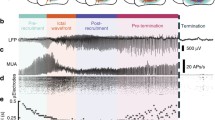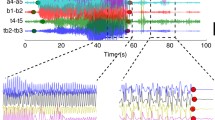Abstract
A model of activity generation in the epileptic focus was proposed based on the ideas that synchronization occurs between the oscillations that arise to regulate the resting potential level and that neuronal discharges are synchronized with slow oscillations. Four phases were identified in seizure development: an increase in slow-wave activity, high-frequency spike activity, synchronization in the presence of sharp peaks, and extinction of the seizure. The model was compared with an intraoperative electrocorticography record.






Similar content being viewed by others
REFERENCES
V. A. Karlov, Epilepsy in Children and adult Women and Men (Meditsina, Moscow, 2010) [in Russian].
Clinical Electroencephalography, Ed. by O. Mecarelli (Springer, New York, 2019).
Clinical Neurophysiological Studies, Ed. by E. M. Troshina (Moscow, 2019) [in Russian].
M. N. Zhadin, Biophysical Mechanisms of Electroencephalogram Formation (Nauka, Moscow, 1984) in Russian].
E. L. Masherov, Electrochemical Feedback as a Possible Mechanism for Generation the Low-frequency Component of Bioelectrical Activity of the Brain, Biophysics (Moscow) 64 (3), 448 (2019).
N. E. Huang and S. S. P. Shen, Hilbert–Huang Transform and Its Applications (World Scientific, London, 2005).
M. A. Samuels and A. H. Ropper, Samuel’s Manual of Neurologic Therapeutics (LWW, Philadelphia, 2017).
C. A. Edwards, A. Kouzani, K. L. Lee, and E. K. Ross, Mayo Clinic Proc. 92 (9), 1427 (2017).
ACKNOWLEDGMENTS
I am grateful to N.A. Arkhipova, L.B. Ivanov, A.B. Kozlova, M.A. Kulikov, V.I. Luk’yanov, L.B. Oknina, K.Yu. Sarkosova, M.Yu. Chelyapina, and E.V. Sharova for help and valuable comments.
Funding
This work was supported by the Russian Foundation for Basic Research (project no. 18-013-00967a).
Author information
Authors and Affiliations
Corresponding author
Ethics declarations
Conflict of interests. The author declares that he has no conflict of interest.
This work does not contain any studies involving animals or human subjects performed by the author.
Additional information
Translated by T. Tkacheva
Abbreviations: EEG, electroencephalogram.
Rights and permissions
About this article
Cite this article
Masherov, E.L. A Model of Activity Generation in the Epileptic Focus. BIOPHYSICS 66, 665–670 (2021). https://doi.org/10.1134/S0006350921040114
Received:
Revised:
Accepted:
Published:
Issue Date:
DOI: https://doi.org/10.1134/S0006350921040114




